Communication Barrier, Spillover Effect and Industrial-Technological Innovation
Abstract
1. Introduction
- How to divide the process of ITI?
- What factors can influence ITI?
- How does the communication barrier (CB) and spillover effect (SE) affect ITI?
2. Literature Review
3. Model Development
3.1. The Theoretical Background Analysis
3.1.1. Analysis of LTI
3.1.2. Analysis of IDTI
3.2. Structure and Loops of ITI
3.3. Simulation Model Formation
3.3.1. System Variables and Boundaries
3.3.2. Simulation Model and Variables Code
3.4. The Model Equation
3.4.1. Demand and LTI Willingness
3.4.2. IDTI Willingness
3.4.3. Product Comparison Gap and Firm Crisis Feeling
((TI/(TI + “LTI&UI” + NTLI))))
3.4.4. Technology Spillover Effect
((COOR × COO/2 + COMR × COM) × ABS(S)))
3.4.5. Others
4. Data and Model Testing
4.1. Date
4.2. Model Testing
4.2.1. Output Fitting of Historical Data
4.2.2. Sensitivity Testing
5. System Simulation and Results
5.1. Simulation and Results of SE
5.2. Simulation and Results of CB
6. Conclusions and Suggestions
6.1. Conclusions
6.2. Suggestions
Author Contributions
Funding
Conflicts of Interest
References
- Loke, B. China’s economic slowdown: Implications for Beijing’s institutional power and global governance role. Pac. Rev. 2018, 31, 673–691. [Google Scholar] [CrossRef]
- Liu, C.; Guo, Q. Technology Spillover Effect in China: The Spatiotemporal Evolution and Its Drivers. Sustainability 2019, 11, 1694. [Google Scholar] [CrossRef]
- Feng, T.; Sun, L.; Zhang, Y. The relationship between energy consumption structure, economic structure and energy intensity in China. Energy Policy 2009, 37, 5475–5483. [Google Scholar] [CrossRef]
- Ramaswami, A.; Jiang, D.; Tong, K.; Zhao, J. Impact of the Economic Structure of Cities on Urban Scaling Factors: Implications for Urban Material and Energy Flows in China. J. Ind. Ecol. 2017, 79, 16115. [Google Scholar] [CrossRef]
- Dong, J.; Xu, Y.; Hwang, B.G.; Ren, R.; Chen, Z. The Impact of Underground Logistics System on Urban Sustainable Development: A System Dynamics Approach. Sustainability 2019, 11, 1223. [Google Scholar] [CrossRef]
- Zheng, J.H.; Song, J.; Zhang, Y.C.; Zheng, Y.; Jiang, Q.K. The Evaluation of Conversion of New and Old Driving Force of China’s Economic Growth. China Ind. Econ. 2018, 6, 24–42. [Google Scholar]
- Du, M.; Wang, B.; Zhang, N. National research funding and energy efficiency: Evidence from the National Science Foundation of China. Energy Policy 2018, 120, 335–346. [Google Scholar] [CrossRef]
- Harrison, R.; Scheela, W.; Lai, P.C.; Vivekarajah, S. Beyond institutional voids and the middle-income trap: The emerging business angel market in Malaysia. Asia Pac. J. Manag. 2017, 35, 965–991. [Google Scholar] [CrossRef]
- Lingliang, Z. Conceptual Analysis of China’s Belt and Road Initiative: A Road towards a Regional Community of Common Destiny. Chin. J. Int. Law 2016, 15, 21. [Google Scholar] [CrossRef]
- Liu, S.X. Innovation Design: Made in China 2025. Des. Manag. Rev. 2016, 27, 52–58. [Google Scholar]
- Singh, R.; O’Hagan, F. “Apping Up”: Prospects for Information Technology Innovation in Return to Work Communication. J. Occup. Rehabil. 2018, 29, 104–118. [Google Scholar] [CrossRef]
- Choi, S.; Noh, M.S.; Yoon, J.; Park, H.; Seo, W. Analyzing Technological Spillover Effects between Technology Classes: The Case of Korea Technology Finance Corporation. IEEE Access 2018, 6, 3573–3584. [Google Scholar] [CrossRef]
- Grupp, H. Spillover effects and the science base of innovations reconsidered: An empirical approach. J. Evol. Econ. 1996, 6, 175–197. [Google Scholar] [CrossRef]
- Srholec, M. Understanding the diversity of cooperation on innovation across countries: Multilevel evidence from Europe. Pap. Innov. Stud. 2015, 24, 159–182. [Google Scholar] [CrossRef]
- Liu, X.; Buck, T. Innovation performance and channels for international technology spillovers: Evidence from Chinese high-tech industries. Res. Policy 2007, 36, 355–366. [Google Scholar] [CrossRef]
- Weber, B.; Heidenreich, S. Improving innovation capabilities by cooperation: Examining effects of core network management functions and relational mechanisms in the industrial goods sector. Int. J. Innov. Manag. 2016, 20, 1650074. [Google Scholar] [CrossRef]
- Stejskal, J.; Meričková, B.M.; Prokop, V. The cooperation between enterprises: Significant part of the innovation process—A case study of the czech machinery industry. E M Èkon. Manag. 2016, 19, 110–122. [Google Scholar] [CrossRef]
- Tigabu, A.D.; Berkhout, F.; Van Beukering, P. Technology innovation systems and technology diffusion: Adoption of bio-digestion in an emerging innovation system in Rwanda. Technol. Forecast. Soc. Chang. 2015, 90, 318–330. [Google Scholar] [CrossRef]
- Wei, S.; Yong, Z. Compulsory Technology Transfer, Adptive Ripening and Innovation Spillover Effect—From China Industry’s Empirical Evidence. Soft Sci. 2019, 33, 52–55. (In Chinese) [Google Scholar]
- Radicic, D.; Douglas, D.; Pugh, G.; Jackson, I. Cooperation for innovation and its impact on technological and non-technological innovation: Empirical evidence from European SMEs in traditional manufacturing industries. Int. J. Innov. Manag. 2019, 23, 1–41. [Google Scholar] [CrossRef]
- Kang, J.H.; Lee, J.S.; Jang, D.S.; Park, S.S. A Methodology of Partner Selection for Sustainable Industry-University Cooperation Based on LDA Topic Model. Sustainability 2019, 11, 3478. [Google Scholar] [CrossRef]
- Nave, A.; Franco, M. University-Firm cooperation as a way to promote sustainability practices: A sustainable entrepreneurship perspective. J. Clean. Prod. 2019, 230, 1188–1196. [Google Scholar] [CrossRef]
- De Moraes Silva, D.R.; Furtado, A.T.; Vonortas, N.S. University-industry R&D cooperation in Brazil: A sectoral approach. J. Technol. Transf. 2018, 43, 1–31. [Google Scholar]
- Liping, W.; Huiming, L. Organization Distance, Value Co-Creation, and Industry-University-Research Collaborative Innovation Performance. Chin. J. Manag. 2019, 5, 704–711. [Google Scholar]
- Forrester, J.W. Industrial Dynamics; MIT Press: Cambridge, MA, USA, 1961; p. 11. [Google Scholar]
- Hayward, J.; Roach, P.A. Newton’s laws as an interpretive framework in system dynamics. Syst. Dyn. Rev. 2018, 33, 183–218. [Google Scholar] [CrossRef]
- Ding, Z.; Zhu, M.; Tam, V.W.; Yi, G.; Tran, C.N. A system dynamics-based environmental benefit assessment model of construction waste reduction management at the design and construction stages. J. Clean. Prod. 2018, 176, 676–692. [Google Scholar] [CrossRef]
- Biondi, G.; Onori, R.; Volpetti, C.; Carlini, C.; Tsaples, G.; Armenia, S. A system dynamics simulation tool for the management of extreme events in urban transportation systems. Int. J. Crit. Infrastruct. 2018, 13, 329. [Google Scholar] [CrossRef]
- Xu, T.; Birchfield, A.B.; Overbye, T.J. Modeling, Tuning, and Validating System Dynamics in Synthetic Electric Grids. IEEE Trans. Power Syst. 2018, 33, 6501–6509. [Google Scholar] [CrossRef]
- Tunzelmann, N.V.; Wang, Q. An evolutionary view of dynamic capabilities. Manag. Acc. Res. 2003, 6, 47–62. [Google Scholar]
- Tunzelmann, N.V.; Wang, Q. Capabilities and production theory. Struct. Chang. Econ. Dyn. 2007, 18, 192–211. [Google Scholar] [CrossRef]
- Rapp, F. Analytical Philosophy of Technology; Springer: Berlin, The Netherlands, 1985; pp. 77–78. [Google Scholar]
- Winter, S. Knowledge and Competence as Strategic Assets. Strateg. Manag. Int. Cap. 1998, 10, 165–187. [Google Scholar]
- Bo, C.; Eliasson, G. The Nature and Importance of Economic Competence. Ind. Corp. Chang. 1991, 3, 687–711. [Google Scholar]
- Martínez-Román, J.A.; Romero, I. Determinants of innovativeness in SMEs: Disentangling core innovation and technology adoption capabilities. Rev. Manag. Sci. 2017, 11, 1–27. [Google Scholar] [CrossRef]
- Broekel, T.; Rogge, N.; Brenner, T. The innovation efficiency of German regions—A shared-input DEA approach. Rev. Reg. Res. 2018, 38, 77–109. [Google Scholar] [CrossRef]
- Lee, H.; Cha, S.; Park, H. The effect of technology-exploration on product innovation: An analysis based on Korean manufacturing SMEs. Int. J. Qual. Innov. 2016, 2, 285. [Google Scholar] [CrossRef]
- Zoia, M.G.; Barbieri, L.; Cortelezzi, F.; Marseguerra, G. The determinants of Italian firms’ technological competencies and capabilities. Eurasian Bus. Rev. 2018, 8, 453–476. [Google Scholar] [CrossRef]
- Fang, C.; Ma, H.; Wang, Z.; Li, G. The sustainable development of innovative cities in China: Comprehensive assessment and future configuration. J. Geogr. Sci. 2014, 24, 1095–1114. [Google Scholar] [CrossRef]
- Kalapouti, K.; Petridis, K.; Malesios, C.; Dey, P.K. Measuring efficiency of innovation using combined Data Envelopment Analysis and Structural Equation Modeling: Empirical study in EU regions. Ann. Oper. Res. 2017, 1–24. [Google Scholar] [CrossRef]
- Miao, Y.; Song, J.; Lee, K.; Jin, C. Technological catch-up by east Asian firms: Trends, issues, and future research agenda. Asia Pac. J. Manag. 2018, 35, 639–669. [Google Scholar] [CrossRef]
- Rieu, A.M. Innovation today: The Triple Helix and research diversity. Triple Helix 2014, 1, 237. [Google Scholar] [CrossRef]
- Rosenzweig, S. The effects of diversified technology and country knowledge on the impact of technological innovation. J. Technol. Transf. 2017, 42, 564–584. [Google Scholar] [CrossRef]
- Lee, C.Y.; Lee, J.H.; Gaur, A.S. Are large business groups conducive to industry innovation? The moderating role of technological appropriability. Asia Pac. J. Manag. 2017, 34, 1–25. [Google Scholar] [CrossRef]
- Wang, R.H.; Lv, Y.B.; Duan, M. Evolutionary game of inter-firm knowledge sharing in innovation cluster. Evol. Syst. 2016, 8, 121–133. [Google Scholar] [CrossRef]
- Alba, M.F.; Mas-Verdú, F. New firm creation and innovation: Industrial patterns and inter-sectoral linkages. Int. Entrep. Manag. J. 2013, 9, 501–519. [Google Scholar] [CrossRef]
- Zhou, G. An Empirical Study of the Technological Innovation Cooperation Performance between the Resource-Based Enterprises; Springer: Berlin/Heidelberg, Germany, 2014; pp. 1207–1218. [Google Scholar]
- Lee, C.; Park, G.; Kang, J. The impact of convergence between science and technology on innovation. J. Technol. Transf. 2016, 43, 522–544. [Google Scholar] [CrossRef]
- Xie, L.; Wang, S. The effect of domestic and foreign trade coordination on technological innovation: Complements or substitutes? Front. Bus. Res. China 2017, 11, 14. [Google Scholar] [CrossRef]
- Bass, F.M. A New Product Growth for Model Customer Durables. Manag. Sci. 1969, 5, 215–227. [Google Scholar] [CrossRef]
- Zhu, K.; Kraemer, K.L.; Xu, S.; Dedrick, J. Information technology payoff in e-business environments: An international perspective on value creation of e-business in the financial services industry. J. Manag. Inform. Syst. 2004, 1, 17–54. [Google Scholar] [CrossRef]
- Davis, F.D. User Acceptance of Information Technology:System Characteristics, User Perceptions and Behavioral Impacts. Int. J. Man Mach. Stud. 1993, 3, 475–487. [Google Scholar] [CrossRef]
- China Statistical Yearbook (1981–2018). Available online: http://data.cnki.net/Yearbook/ Single/%20N2018110025 (accessed on 20 May 2019). (In Chinese).
- Kiermer, V. Six degrees of separation. Nat. Methods 2006, 3, 964. [Google Scholar] [CrossRef]
- JIGUANG Smart Phone Industry Research Report. Available online: https://doc.mbalib.com/view/5bc89c03945c 8911ca99578df80c3f05.html (accessed on 12 May 2019). (In Chinese).
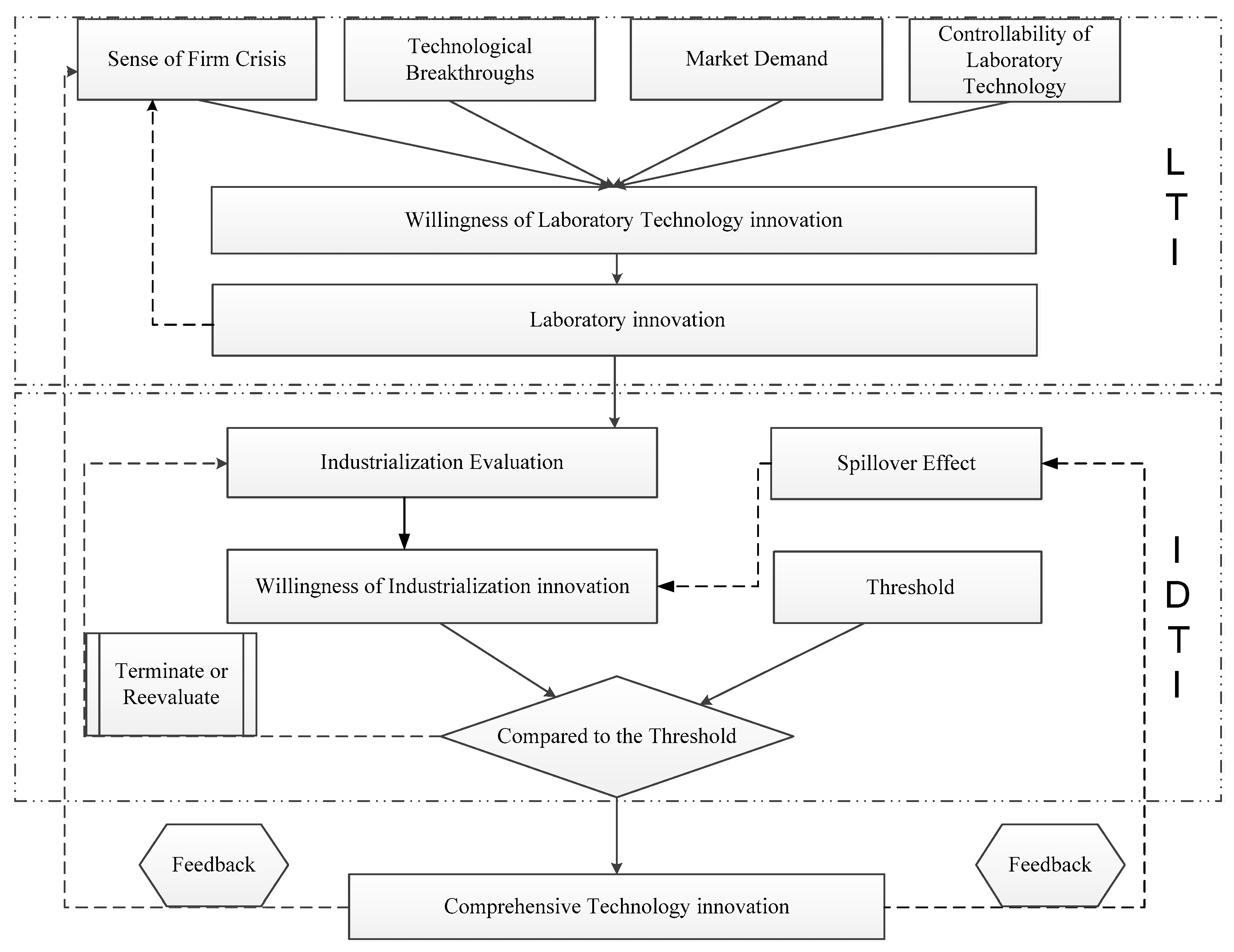
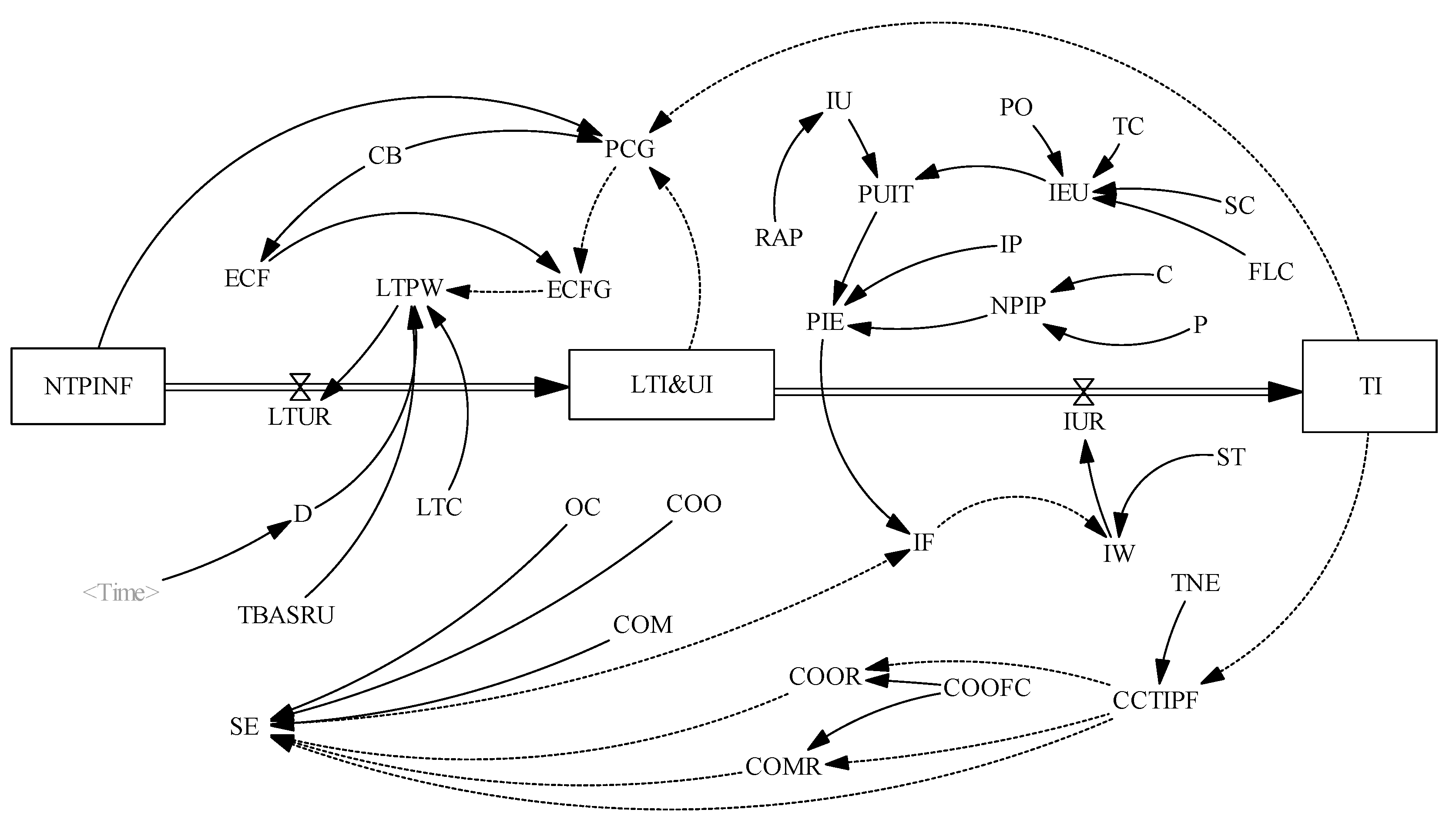
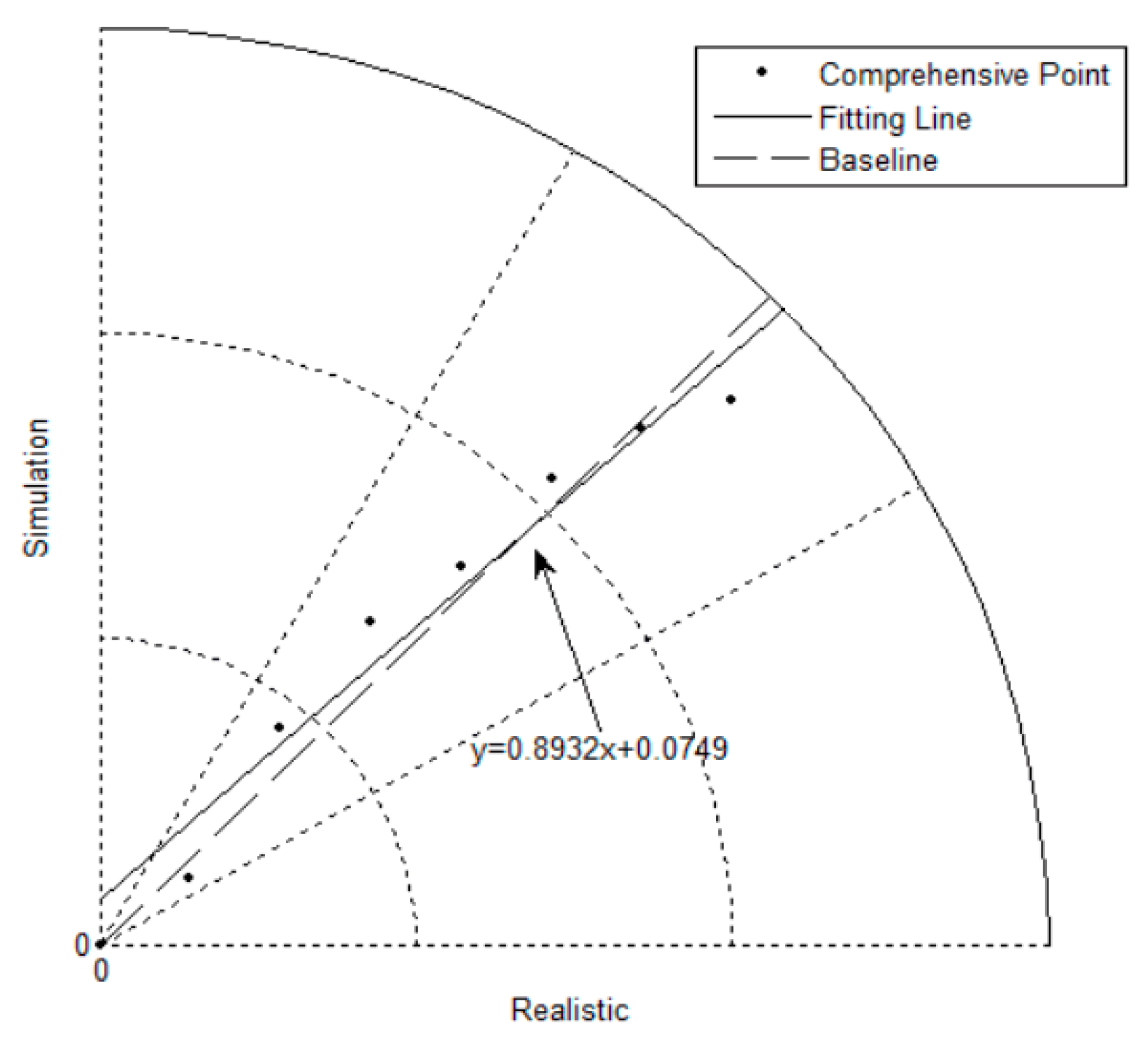
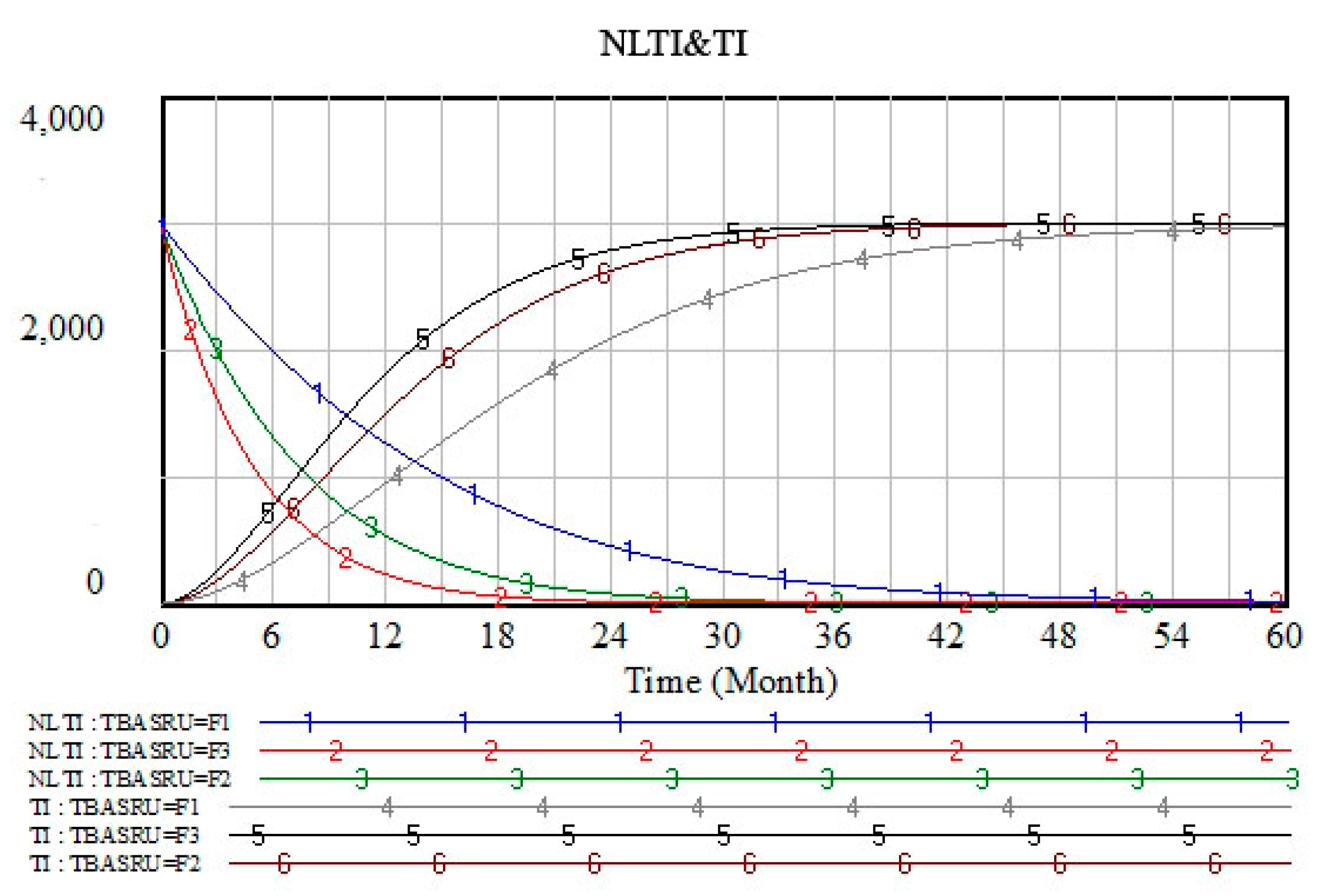
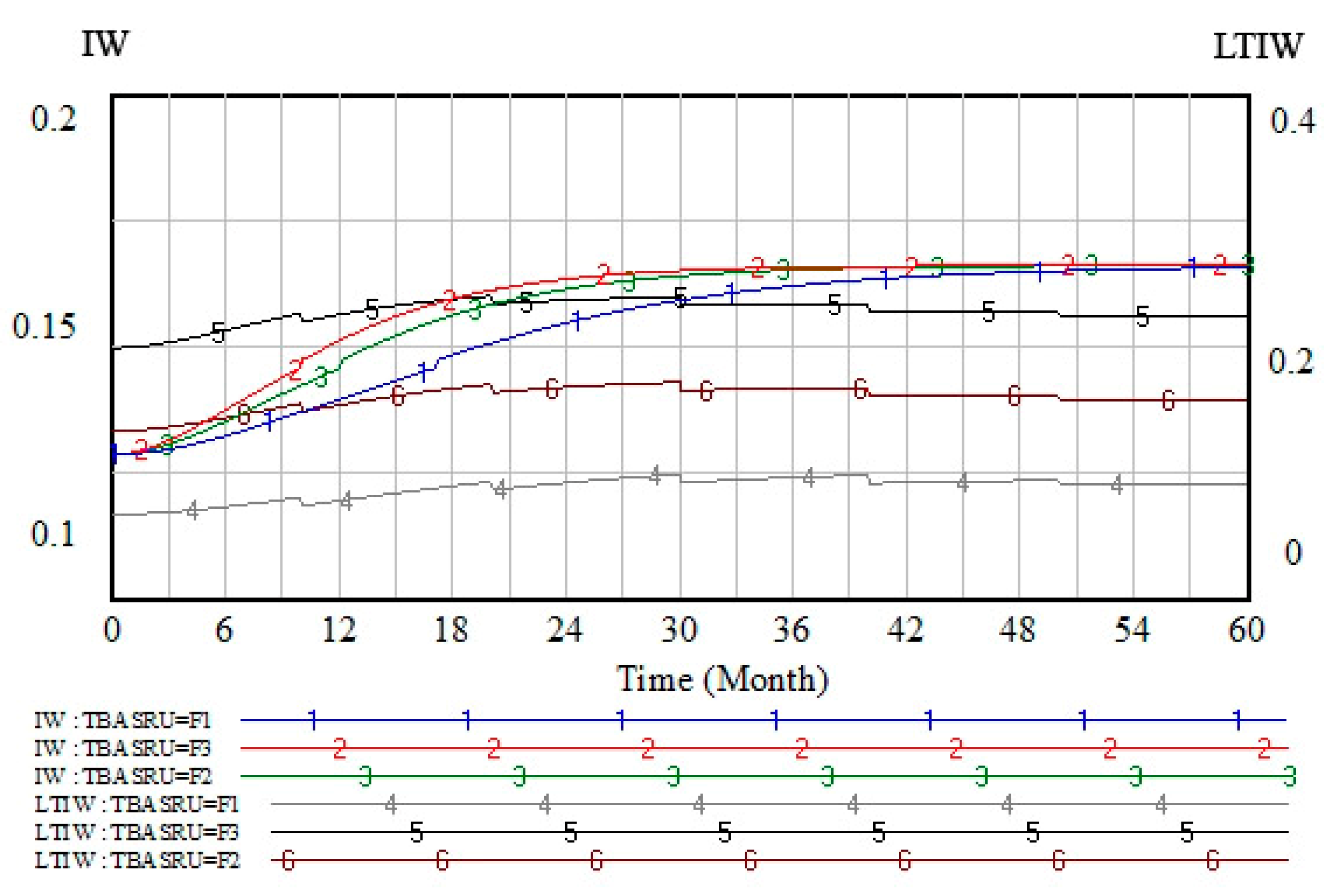
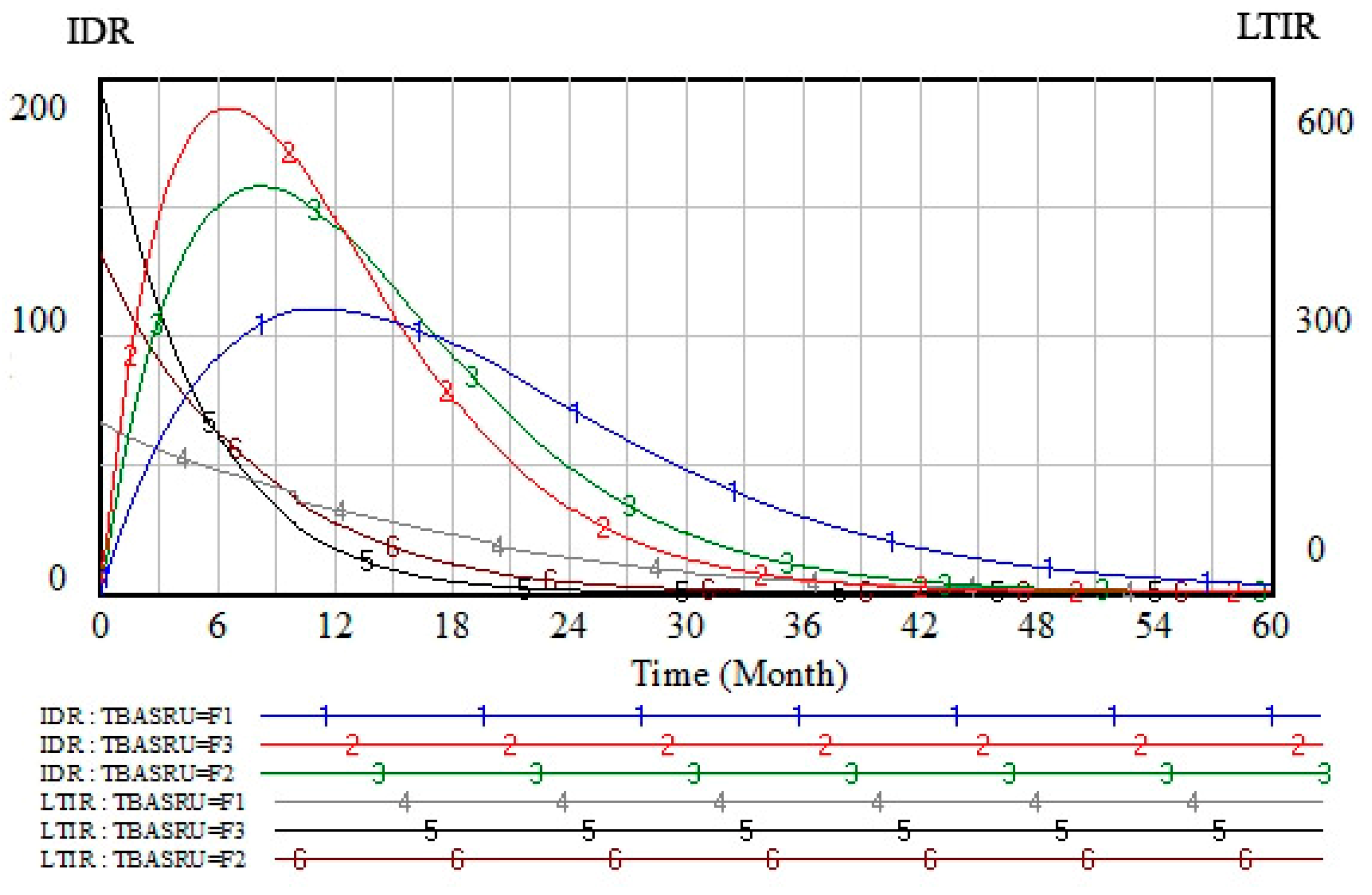
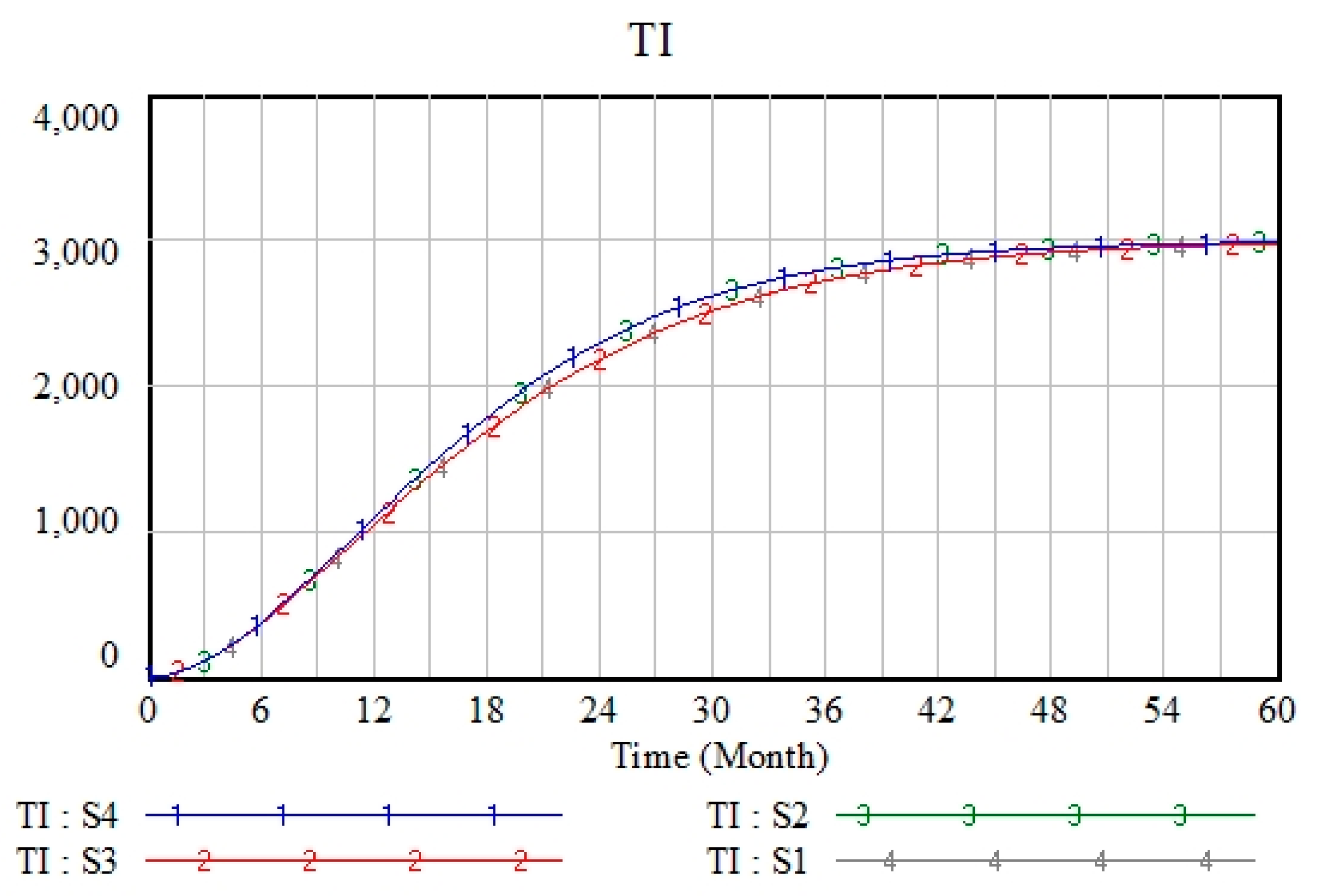
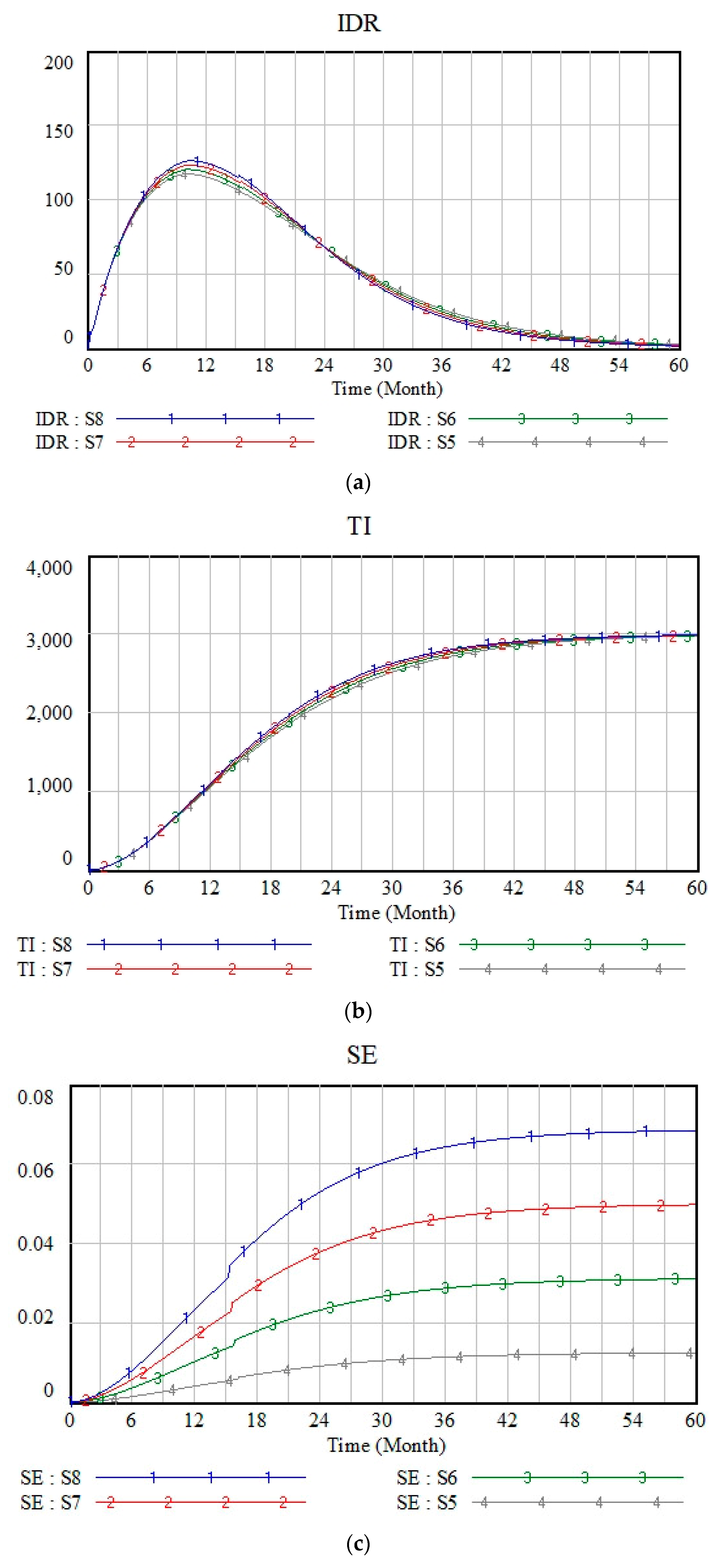
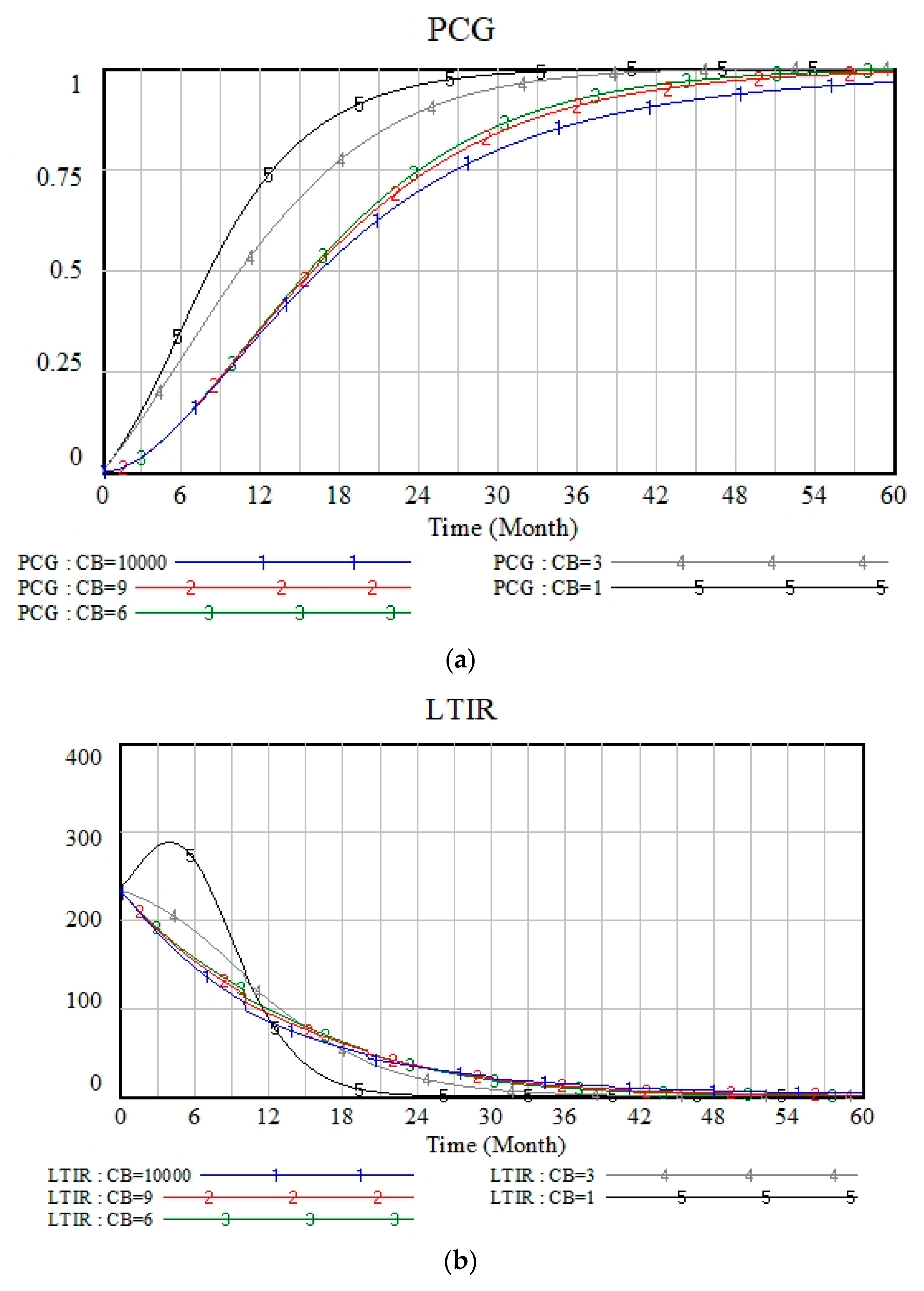
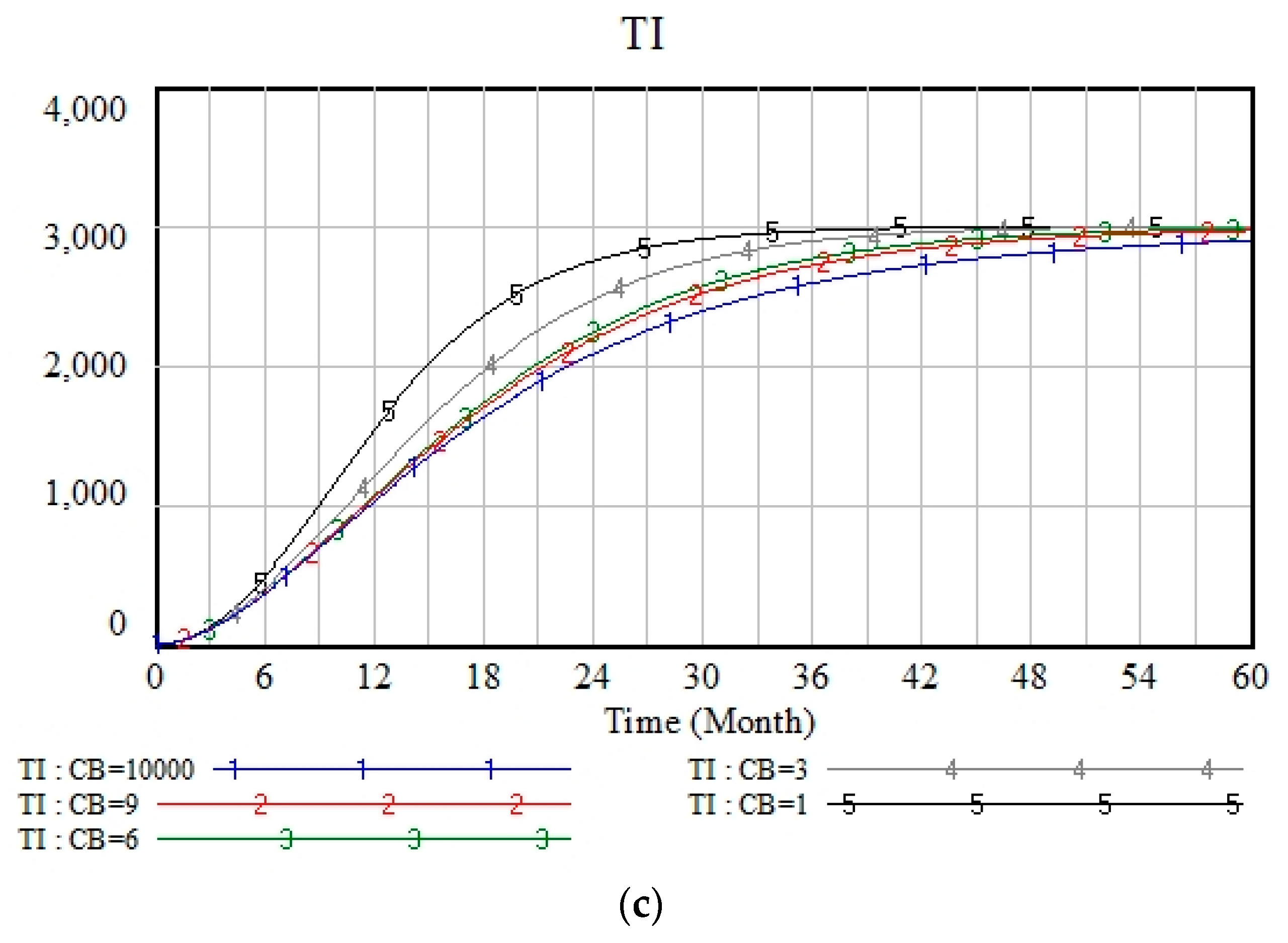
| Category | Variables |
|---|---|
| Forward Loop | sense of firm crisis, etc.—willingness of LTI—Lab. innovation—Industrialization evaluation—willingness of IDTI—ITI |
| Feedback Loop1 | ITI—sense of firm crisis—Forward Loop—ITI |
| Feedback Loop2 | ITI—Spillover effect—willingness of IDTI—ITI |
| Feedback Loop3 | Compared to the threshold—Industrialization evaluation—willingness of IDTI—Compared to the threshold |
| Feedback Loop4 | Lab. Innovation—sense of firm crisis, etc.—willingness of LTI—Lab. Innovation |
| Code | Variable | Reference |
|---|---|---|
| NLTI | Number of firm without LTI | [50] |
| LTI&UI | Number of LTI improvement & unimproved IDTI | [50] |
| TI | Total ITI | [50] |
| LTIR | LTI rate | [50] |
| IDR | IDTI rate | [50] |
| LTIW | LTI willingness | [50] |
| IW | IDTI willingness | [50] |
| FCF | Firm crisis feeling | [43] |
| LTIC | LTI Controllability | [44] |
| TBASRU | Technological breakthrough of scientific research units | [35,36] |
| D | Demand | [37] |
| FCFR | Firm communication frequency | [43] |
| CB | communication barrier | [2] |
| PCG | Product comparison gap | [37] |
| SE | Spillover effect | [39] |
| S | Spillover coefficient | [39] |
| COO | Cooperative spillover strength | [39] |
| COM | Competitive spillover intensity | [39] |
| COOR | Cooperation firm ratio | [20] |
| COMR | Competition firm ratio | [20] |
| COOFC | Cooperative firm coefficient | [20] |
| ITICR | ITI completion rate | [50] |
| TNF | Total number of firm | [50] |
| ST | Start threshold | [49] |
| IF | Industrialization feasibility | [51] |
| NP | New product industrialization evaluation | [50] |
| IPF | Individual preference of firm | [22] |
| IP | Industrial profit | [52] |
| C | Cost | [52] |
| P | Profit | [52] |
| PUIT | Practical utility of industrial technology | [51] |
| IU | Industrial usefulness | [51] |
| RAP | Relative advantage of product | [51] |
| IEU | Industrial ease of use | [51] |
| PO | Product operability | [51] |
| TC | Technical complexity | [51] |
| SC | System compatibility | [51] |
| FLC | Flow control | [51] |
| Variable | Value | Foundation | Date |
|---|---|---|---|
| TBASRU | 0.136 | Outstanding Youth Science Foundation passing rate | China Statistical Yearbook [53] |
| ST | 0.112 | 1.5 times the loan interest rate | China Statistical Yearbook [53] |
| LTC | 0.33 | The National Natural Science Foundation of China passing rate | China Statistical Yearbook [53] |
| RAP | 0.135 | Delphi Method | Expert Groups and Surveys |
| SC | 0.679 | Delphi Method | Expert Groups and Surveys |
| FLC | 0.369 | Delphi Method | Expert Groups and Surveys |
| PO | 0.579 | Delphi Method | Expert Groups and Surveys |
| TC | 0.236 | Proportion of invention patents | China Statistical Yearbook [53] |
| P | 0.3 | Four times the rate of inflation | China Statistical Yearbook [53] |
| C | 0.15 | Two times the rate of inflation | China Statistical Yearbook [53] |
| IP | 0.156 | Delphi Method | Expert Groups and Surveys |
| OC | 0.3 | Delphi Method | Expert Groups and Surveys |
| COO | 0.3 | Delphi Method | Expert Groups and Surveys |
| COM | 0.1 | Delphi Method | Expert Groups and Surveys |
| COOEC | 0.3 | Delphi Method | Expert Groups and Surveys |
| TNE | 3000 | Delphi Method | Expert Groups and Surveys |
| CB | 6 | Six Degrees of Separation | Stanley Milgram [54] |
| Code | S1 | S2 | S3 | S4 |
|---|---|---|---|---|
| assignment | 0.2 | 0.5 | −0.2 | −0.5 |
| Code | S5 | S6 | S7 | S8 |
|---|---|---|---|---|
| assignment | 0.1 | 0.25 | 0.4 | 0.55 |
© 2019 by the authors. Licensee MDPI, Basel, Switzerland. This article is an open access article distributed under the terms and conditions of the Creative Commons Attribution (CC BY) license (http://creativecommons.org/licenses/by/4.0/).
Share and Cite
Guo, J.; Gu, B.; Sun, X.; Xue, J.; Yuan, B. Communication Barrier, Spillover Effect and Industrial-Technological Innovation. Sustainability 2019, 11, 4841. https://doi.org/10.3390/su11184841
Guo J, Gu B, Sun X, Xue J, Yuan B. Communication Barrier, Spillover Effect and Industrial-Technological Innovation. Sustainability. 2019; 11(18):4841. https://doi.org/10.3390/su11184841
Chicago/Turabian StyleGuo, Jin, Bingmei Gu, Xialing Sun, Jinli Xue, and Baiyun Yuan. 2019. "Communication Barrier, Spillover Effect and Industrial-Technological Innovation" Sustainability 11, no. 18: 4841. https://doi.org/10.3390/su11184841
APA StyleGuo, J., Gu, B., Sun, X., Xue, J., & Yuan, B. (2019). Communication Barrier, Spillover Effect and Industrial-Technological Innovation. Sustainability, 11(18), 4841. https://doi.org/10.3390/su11184841





